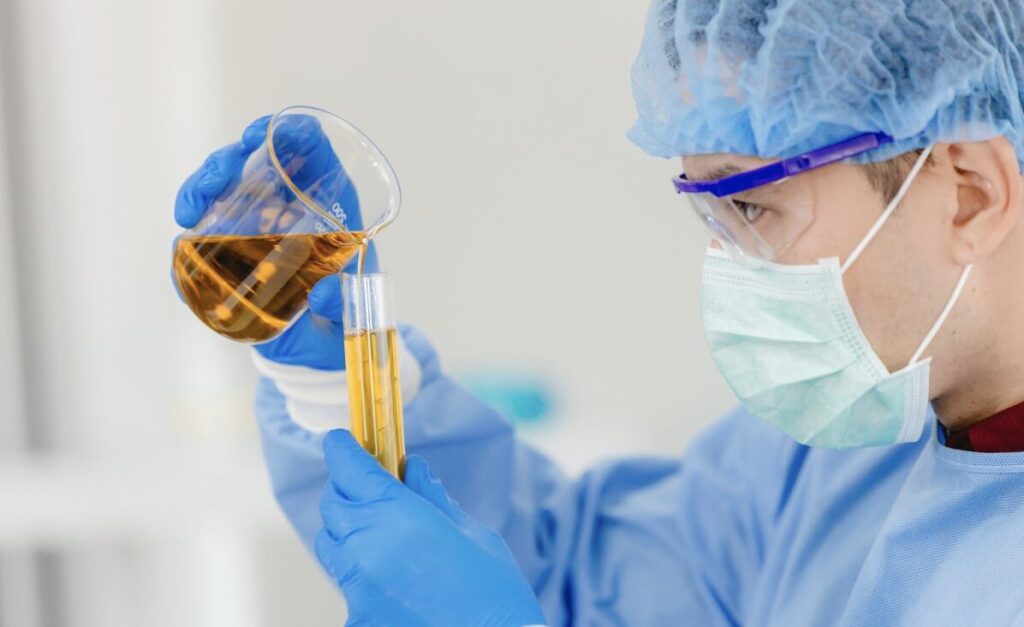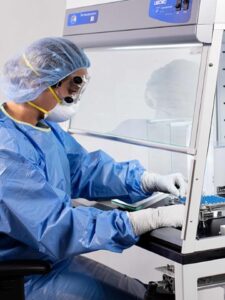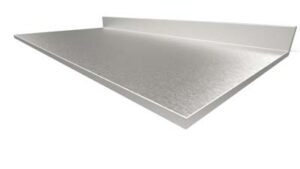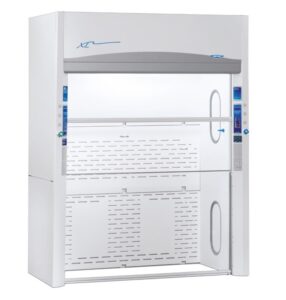Home » Laboratory Essentials for Biotech Laboratories
Laboratory Essentials for Biotech Laboratories
on February 15, 2024 in Blogs

Table of Contents
In the dynamic realm of biotechnology, the quest for groundbreaking treatments hinges on more than just scientific insights. It requires laboratories equipped with the specialized tools.
The essentials of every biotech lab are biopharmaceuticals, biotech fume hoods, and bio safety cabinets. These are critical investments and allow researchers can more safely navigate the complexities of living organisms and biological systems.
Inside the Market of Emerging Biotechs
The emerging biotech market is characterized by rapid innovation and intense competition where quality lab equipment can make a significant difference. The race to innovate and outpace competitors is relentless.
The right lab equipment isn’t just about doing experiments; it’s about making breakthroughs where quality and precision can’t be compromised.
High-quality biotech lab equipment enhances the precision and reliability of experimental data, which is crucial when stakes are high and even minor errors can lead to substantial setbacks.
Being equipped with top-tier fume hoods, bio safety cabinets, and advanced biopharmaceutical instruments ensures that a biotech lab can uphold rigorous safety standards and produce accurate, reproducible results that stand up to scrutiny in the global marketplace.
Biopharmaceutical Industry Overview
The biopharmaceutical sector is at the cutting edge of healthcare medicine, turning groundbreaking research into new treatments made from biological processes. Unlike traditional drugs made from chemicals, biopharmaceuticals use complex molecules created in living organisms.
Investing heavily in research and development is crucial in this industry, focusing on combating and preventing serious diseases.
Its rapid expansion is driven by the growing need for innovative vaccines, tailored medical treatments, and new cell and gene therapy techniques.
Biopharmaceuticals
Biopharmaceuticals are essential to biotech laboratories as they provide the necessary ingredients for the production of biologics, such as recombinant proteins, monoclonal antibodies, and gene therapies. These ingredients are derived from living organisms and must be produced under sterile conditions, making biopharmaceuticals an essential aspect of biotech laboratory equipment. In addition, biopharmaceuticals must be stored and transported under specific conditions to maintain their integrity.
Essential Laboratory Equipment in Biopharmaceutical Labs
In the biopharmaceutical industry, laboratories are equipped with a range of specialized equipment to facilitate the research, development, and production of biotherapeutics. These include:
- Sterile Workstations: Biopharmaceutical production often involves the manipulation of sensitive biological materials. Laminar flow cabinets and biological safety cabinets provide sterile environments to avoid contamination.
- Stainless Steel Countertops: Required biopharmaceutical labs due to their high resistance to corrosion, heat, and chemical spills, which makes them ideal for handling strong reagents and bioactive substances. These surfaces are easy to clean and disinfect, which is critical in maintaining stringent sterility standards necessary for the production and manipulation of sensitive biological materials. Additionally, their durability ensures longevity even in the demanding environment of a biotech lab, where experiments may run for extended periods and require a workspace that can withstand rigorous use.
- Biotech Fume Hoods: Biotech fume hoods are essential laboratory equipment that protects laboratory workers from hazardous substances and vapors. These fume hoods are designed to capture and contain fumes generated during laboratory experiments, ensuring the safety of laboratory personnel. Biotech fume hoods come in different shapes and sizes, making them suitable for different types of experiments.
Bio Safety Cabinets: Sterility and Safety
Biotech bio safety cabinets are used to provide a barrier between the laboratory user and the biological agents, pathogens, and toxins being used in the laboratory. Bio safety cabinets come in three different types; class I, class II, and class III. Each cabinet type offers different levels of protection, with class III cabinets offering the highest level of protection. Biotech bio safety cabinets are essential laboratory equipment that provides a safe working environment for laboratory personnel.
- Class I: Provides personnel and environmental protection but no product protection. It has an open front and operates by drawing air in, preventing harmful aerosols from escaping the cabinet.
- Class II: Offers personnel, environmental, and product protection. It is equipped with a vertical laminar airflow to ensure a sterile work area. Class II cabinets are further divided into types A1, A2, B1, and B2, each with specific airflow patterns, filtration systems, and exhaust systems tailored to different safety requirements.
- Class III: Provides the highest level of protection for personnel, the environment, and the product. It is a completely enclosed, gas-tight cabinet designed for high-risk microbiological agents and provides protection through a system of gloves attached to the front of the cabinet.
Usage of Bio Safety Cabinets in the Biotech Industry
BSCs are an essential component of laboratory safety, particularly in biotechnology labs, where researchers work with biological samples that could be harmful or require strict containment to prevent cross-contamination.
These cabinets are where living cells are manipulated and cultivated for use in various products and therapies. During the production process, the safety cabinets serve as a sterile environment, ensuring the integrity and purity of the living cells being used.
Bio safety cabinets are vital not just for safety but also for quality control in biotech. They provide a clean, controlled space for checking samples against strict industry standards. Without them, achieving the high level of quality needed for biopharmaceuticals would be much harder.
Industries and Applications Using Bio Safety Cabinets
Bio safety cabinets (BSCs) are instrumental in various industries and applications that prioritize sterility and safety. In the field of clinical studies, BSCs provide the controlled environment necessary for the meticulous handling and analysis of blood components, ensuring the integrity of samples that could lead to pivotal discoveries in drug development. In the production of growth hormone therapies, BSCs contribute to the rigorous standards required to produce potent and uncontaminated therapeutic agents.
The pharmaceutical industry relies on BSCs for the safe manipulation of drug compounds, particularly when those compounds are derived from or include live biological agents. This is critical in the development of therapeutics designed to treat complex diseases, where the purity of the drug is paramount to its efficacy.
In oncology, researchers and technicians use BSCs for developing treatments and handling delicate processes involving carcinogenic materials. The contained environment that BSCs provide is essential for protecting both the personnel and the integrity of cancer therapeutics under development. Moreover, in disease research labs, scientists utilize BSCs extensively while working with infectious agents, ensuring that rigorous containment measures are in place to prevent any potential biohazards from affecting both researchers and the external environment.
Biological Testing in Biotech Laboratories
Bio safety cabinets are essential in biotech labs, especially for developing new medical treatments like gene therapy, clinical trials, and small molecule drugs.
These cabinets are key for research involving dangerous pathogens and sensitive cell cultures, providing a sterile environment that prevents contamination. They are critical for various tasks: from genetic experiments in gene therapy, to analyzing clinical trial samples, to creating small molecule drugs.
The controlled conditions within bio safety cabinets ensure experiments are accurate and results can be replicated. This makes them vital for advancing medical research and safely bringing new treatments to market.
Biological testing is crucial not only for developing treatments but also for ensuring tissue compatibility in transplants and evaluating vaccine effectiveness. In biotech labs, bio safety cabinets are vital for safely handling tissues and preventing immune rejection after transplants. They enable precise matching of donor tissues with recipients, greatly increasing the chances of transplant success.
Additionally, vaccines are rigorously tested within these cabinets during clinical trials to confirm their safety and effectiveness, ensuring no cross-contamination affects the results. This careful testing within bio safety cabinets is key to validating vaccines before they’re approved and released, helping to protect public health.
Frequently Asked Questions for New Lab Startups
Q: What is the first step in selecting the right bio safety cabinet for my new lab?
A: The first step is to assess the type of work you will be conducting in your lab. Consider the level of protection needed for your personnel, environment, and product. For basic research that requires protection for users and the environment but not the product, a Class I cabinet may suffice. If your work involves toxic chemicals or requires sterility, a Class II or Class III cabinet might be necessary.
Q: How do I determine which Class II cabinet type is suitable for my biotech applications?
A: BSC cabinets are divided into types A2, B2, and C1. The selection depends on factors such as the presence of volatile toxic chemicals and the need for a specific airflow pattern. For instance, if you work with minute quantities of toxic chemicals, a Type A2 might be appropriate. If large quantities of toxic chemicals are involved, a Type B2 would be necessary as it has a hard-ducted exhaust system.
Q: What maintenance procedures are recommended for bio safety cabinets?
A: Regular maintenance includes cleaning and decontaminating the work surface and interior walls after use, checking and replacing HEPA filters as needed, and certifying the cabinet annually to ensure proper airflow and filter integrity. It’s essential to follow the manufacturer’s maintenance guidelines to ensure optimal performance.
Q: What are the electrical requirements for a BSC?
A: The standard power cord and plug for bio safety cabinets in North America is rated at 115V, 15A. However, for laboratories equipped with the corresponding electrical infrastructure, there is also a 230V option available. It is important to ensure that your lab’s electrical system is compatible with the BSC’s requirements before installation to provide safe and reliable power to the unit.
Conclusion
In conclusion, biotech laboratories require the use of specialized equipment and safety measures to ensure safe and effective experiments. Biopharmaceuticals, biotech fume hoods, and biotech bio safety cabinets are essential laboratory equipment that provides a safe working environment for laboratory personnel.
While the use of specialized equipment is important, proper safety measures must also be in place to ensure a safe laboratory environment. By using the proper laboratory equipment and following safety measures, biotech laboratories can produce the necessary biologics for the betterment of humankind.
Author
-
Dave Young is the founder and President of Specialty Solutions. His passion for laboratory equipment began during my days as a design/mechanical engineer in the industry.
View all posts
Witnessing the incredible work done in labs every day fueled his desire to contribute, and over the past 10+ years, He has built a team that shares his dedication to quality and service. My mission is clear: Supporting Science with Safer Spaces.



